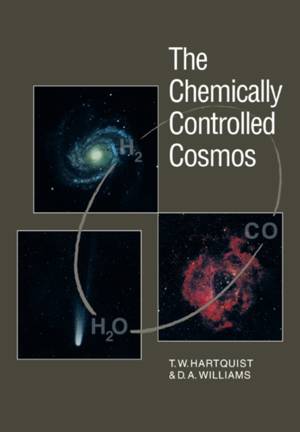
- Afhalen na 1 uur in een winkel met voorraad
- Gratis thuislevering in België vanaf € 30
- Ruim aanbod met 7 miljoen producten
- Afhalen na 1 uur in een winkel met voorraad
- Gratis thuislevering in België vanaf € 30
- Ruim aanbod met 7 miljoen producten
Zoeken
The Chemically Controlled Cosmos
Astronomical Molecules from the Big Bang to Exploding Stars
T W Hartquist, D A Williams
Paperback | Engels
€ 76,45
+ 152 punten
Uitvoering
Omschrijving
Simple chemistry governs a host of the exotic objects that populate our cosmos. For example, molecules in the early Universe acted as natural temperature regulators, keeping the primordial gas cool and, in turn, allowing galaxies and stars to form. What are the tools of the trade for the cosmic chemist and what can they teach us about the Universe we live in? These are the questions answered in this engaging and informative guide--the first book for nonspecialists on molecular astrophysics. In clear, nontechnical terms, and without formal mathematics, Hartquist and Williams show how to study and understand the behavior of molecules in a host of astronomical situations. Readers will learn about the secretive formation of stars deep within interstellar clouds; the origin of our own solar system; the cataclysmic deaths of many massive stars that explode as supernovae; and the hearts of active galactic nuclei, the most powerful objects in the universe. This book provides an accessible introduction to a wealth of astrophysics, and an understanding of how cosmic chemistry allows the investigation of many of the most exciting questions concerning astronomy today.
Specificaties
Betrokkenen
- Auteur(s):
- Uitgeverij:
Inhoud
- Aantal bladzijden:
- 188
- Taal:
- Engels
Eigenschappen
- Productcode (EAN):
- 9780521056373
- Verschijningsdatum:
- 24/03/2008
- Uitvoering:
- Paperback
- Formaat:
- Trade paperback (VS)
- Afmetingen:
- 170 mm x 244 mm
- Gewicht:
- 308 g

Alleen bij Standaard Boekhandel
+ 152 punten op je klantenkaart van Standaard Boekhandel
Beoordelingen
We publiceren alleen reviews die voldoen aan de voorwaarden voor reviews. Bekijk onze voorwaarden voor reviews.








